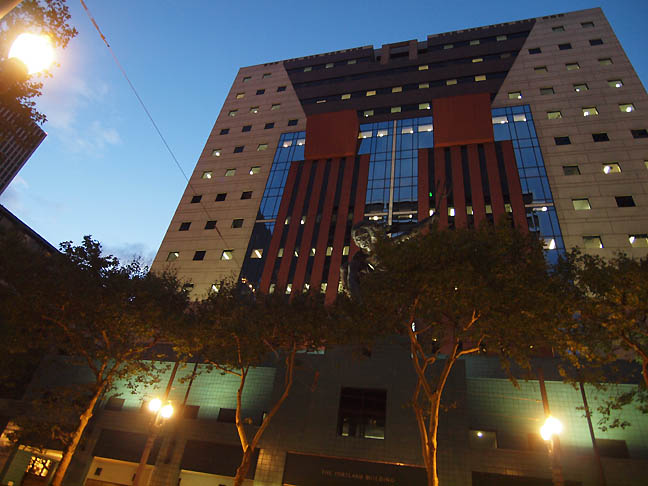
|
||
|
Portland art blog + news + exhibition reviews + galleries + contemporary northwest art
|
||
Michael Graves Dies at 80 | Changed Portland  Portland Building (photo Jeff Jahn) Michael Graves has died at 80 years old today. I wrote about his complicated relationship with Portland and his career making Portland Building here. Suffice it to say Graves changed the City of Portland and influenced the world of architecture with that building and the effects will be felt as long as there are humans who study design. First and foremost Graves was an innovator in what he called, "Humanistic Design" and the Portland Building as designed was a way to relate big buildings back to the human scales and aspirations that make up a city. The Portlandia sculpture (the show's namesake) acts as a kind of divine intermediary between the brutalism of giant rectangular structures and the humans on the bus mall. That is why the entrance is on the western bus mall side and not on the park side and the building's exterior with its sconces and intentional foreshortening is incredibly successful as a pastiche of Greek and Roman motifs. Too bad the city of Portland's government took most of the design control out of Graves hands and the interior became a value engineered mess that contributes to a poor seismic performance and a higher # of sick days from city employees. Still I'd argue that the exterior, aspects of the lobby, elevator zones and the upper floor gallery are worth saving as an important history making bit of architecture. The effect of the building upon the short lived Postmodernist architecture movement was great but I think the way Graves intuited the humanism of Portland was equally important, even if the interior didn't live up to the promise of the exterior. Portland simply isn't like other cities and ironically its citizenry rightfully turned on Graves first major commission when they learned first hand what a dreary dank tomb-like structure their severely underfunded project had bought. The interior did not deliver on the exterior's promise. This inoculated Portland from a lot of top down architecural commissions (Philip Johnson basically rigged the competition to go to Graves) and made the city suspicious of outsiders like Graves. Instead of trophy architecture like Seattle, Portlanders place far more emphasis on public transportation and the quality of life that buildings contribute towards. I'd argue that the failure of Grave's Portland building is where Portland found it's identity as a city of civic humanism first. I've always found it odd how some older Portlanders like Randy Gragg couldn't see the value in saving the Portland Building because of this. What is more is how "very Portland" it is to rehabilitate such a building and it looks like that is the City Council's new plan. The technology of today isn't just about bringing in more fresh light and air, it is also about not throwing away what is valuable and the building IS a showcase of valuable ideas put into practice. Perhaps a flawed one but that could be rectified. Recently the Portland Art Museum's Director Brian Ferriso asked me who if anyone could be trusted with fixing the Portland building locally. I was stumped at the time as most of the local firms are related to Modernism and therefore bear great enmity towards the Portland Building. Yet Graves charged us as a city full of ideas and designers to, "Take care of." The obvious choice would be Graves firm, which will continue but other ex-Postmod names come to mind like my famous relative Helmut Jahn (an architect who also had problems with his first major postmodernist building) and Richard Rogers. There are local firms but I'd be suspicious without seeing actual designs. Overall, what may have seemed like a terrible mistake by Graves became an incredible gift and Portland does owe it to the rest of the world and Graves to get this renovation right. Rest in peace Michael Graves... brave ideas have earned you the rest. Graves visited the Portland Art Museum recently Posted by Jeff Jahn on March 12, 2015 at 14:54 | Comments (0) Comments Post a comment Thanks for signing in, . Now you can comment. (sign out)
(If you haven't left a comment here before, you may need to be approved by
the site owner before your comment will appear. Until then, it won't appear
on the entry. Thanks for waiting.)
|
| s p o n s o r s |
 |
 |
 |
 |
 |
 |
 |
 |
 |
 |
 |
 |
 |
 |
 |
 |

|
Site Design: Jennifer Armbrust | • | Site Development: Philippe Blanc & Katherine Bovee | |

